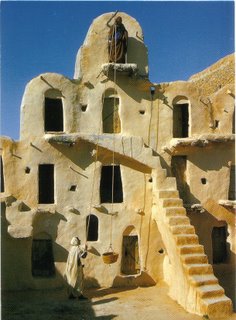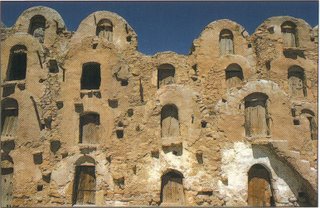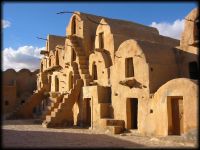Friday, 8 December 2006
Saturday, 2 December 2006
SOUSSE / TUNISIA




In the 11th century B.C., the Phoenicians founded Hadrumetum. The city allied itself with Rome during the Punic Wars, thereby escaping damage or ruin and entered a relatively peaceful 700-year period under Pax Romana. Livy tells us that Hadrumentum was the landing place of the Roman army under Scipio Africanus in the second Punic War.
After the fall of Rome, the Vandals, and later the Byzantines, took over the town, renaming it, respectively, Hunerikopolis and Justinianopolis.
In the 7th century A.D. Arab-Islamic armies conquered what is now Tunisia and rapidly spread Arab culture across what had been a thoroughly Romanized and Christianized landscape. The Arabs seized the city, which in the aftermath of Rome's fall was but a remnant of its former self. They renamed the city Sûsa and within a few decades elevated it to the status of main seaport of the Aghlabid Dynasty.
When the Aghlabids invaded Sicily in 827, Sûsa was their main staging ground.
In the centuries that followed, as Europe gained technological ascendancy and began pushing back at Islam, Sûsa was briefly occupied by the Normans in the 12th century, was later more substantially occupied by the Spanish, and in the 18th century was the target of bombardments by the Venetians and the French. The French renamed the city Sousse.
Despite the turmoil around it, Sousse's character had retained the solidly Arabian look and feel it had assumed in the centuries after Islam's wars of conquest. Today it is considered one of the best examples of seaward-facing fortifications built by the Arabs. Its ribat, a soaring structure that combined the purposes of a minaret and a watch tower, is in outstanding condition and draws visitors from around the world.
These days, Sousse, with a population of more than 430,000, retains a medieval heart of narrow, twisted streets, a kasbah and medina, its ribat fortress and long wall on the Mediterranean. Surrounding it is a modern city of long, straight roads and more widely spaced buildings.
Historical names
Hadrumetum (Punic)
Colonia Concordia Ulpia Trajana Augusta Frugifera Hadrumetina (Roman)
Hunerikopolis (Vandal)
Justinianopolis (Byzantine)
Susa (Arabic)
City assets
Third city of the country after Tunis and Sfax, Sousse owes its status uncontested capital of the region to a certain number of assets :
An olive grove stretching over more than 2,500 square kilometres, constituting one of its main riches since Antiquity.
A bustling port, open to the town centre and giving a touch of gaiety to its activity.
A medina charged with history, draped in its fortifications and which continues to live at its own rhythm, harmoniously contrasting with the modern city of typically Mediterranean charm.
A seaside resort stretching to the north, making up together with the integrated complex of Port El Kantaoui one of the most complete and most diversified tourist zones of the Mediterranean, at only 20 km from the international airport of Monastir. As a sea town, Sousse benefits from a moderate and mild climate promoting all possible pleasures relating to evasion and recreation and making it to an all-season resort.
Tourism
Sousse is home to many resorts and fine sand beaches, backed by orchards and olive groves. It has the further advantages of a pleasant Mediterranean climate, with hot, dry summers and gentle warm, wet winters, a strategic geographic location and a skilled population.
Although Sousse is associated with olive oil making, this is far from being the only industry in the city. Tourism has become a central activity, with some 1,200,000 visitors every year coming to enjoy its fine hotels and restaurants, trendy nightclubs and casinos, beaches and sports facilities, museums and the Medina (the old city).
A strip of 120 hotels with a capacity of 40,000 beds, runs from about 20 km north of town, south to a traditional downtown, and bazaar with wares directed mainly to tourists.
Statistics
Population: 220,000 inhabitants (2003 estimate)
Altitude: 2 m
Humidity: 69%
Number of hospitals: (private and public) 15
Temperatures moyennes: (mean temperatures from May to August for the last 30 years)
Min: 19.7 °C
Max: 29.1 °C
Average: 24.4 °C
Rainfall average: May: 19.3 mm
June: 4 mm
July: 1.7 mm
August: 10.3 mm
Sights
UNESCO declared the medina of Sousse a World Heritage Site in 1988, citing among other things its almost complete intactness.
Sister Cities
Miami, USA
Quebec City, Canada
Sports
The football team of Étoile Sportive du Sahel, from Sousse, is one of the greatest clubs in Africa for having won many continental cups.
External links
Wikimedia Commons has media related to:
Sousse
Sousse travel guide from Wikitravel
DJERBA / TUNISIA



Djerba is a popular tourist destination, particularly for French, German, Italian and Czech tourists. It is one of the few remaining places in Tunisia where a Berber language is still spoken. Another factor drawing some tourists to Djerba is the 1977 location of the Mos Eisley exterior scenes in the first Star Wars movie.
The island is noted as a center of the Islamic sect al-Ibadhiyah and is also noted for its Jewish minority, which has dwelled on the island for centuries, although populations have declined due to emigration to Israel and France since 1967. The El Ghriba synagogue is the oldest and one of the most famous in the world.
In the early 20th century the island of Djerba had a population of forty thousand, several hundreds of whom were Maltese Catholics earning a livelihood as sponge-fishers.
Djerba is also known for its exceptional beaches, landscapes and hotels.
Girba remains a Roman Catholic titular see in the ecclesiastical province of African Tripoli.
[edit] History
Legend has it that Djerba was the island of the Lotus-Eaters where Odysseus stranded on his voyage through the Mediterranean. The island, called Meninx until the third century AD, included three principal towns. In one of these, whose modern name is Būrgū, is found near Midoun in the center of the island, the remains of a large town dating from the fourth century BC are signalled by high mounds and dense pottery, as well as by a major tomb, possibly that of a member of the Numidian royal family. Another city, on the southeast coast of the island at Meninx, was a major producer of murex dye, cited by Pliny the Elder as second only to Tyre in this respect; substantial amounts of coloured marble testify to its wealth. In the third century the same town appears to have been called Girba, whence the present name of the island. At least two bishops of Girba are known, Monnulus and Vincent, who assisted at the Councils of Carthage in 255 and 525 (Toulotte, Géographie de l'Afrique chrétienne Proconsulaire, Paris, 1892, pp. 353 and 380). Their cathedral can be identified with ruins to the southwest of Meninx. A third important town, on the south coast near the modern pottery village of Guellala; was probably the ancient Haribus.
During the Middle Ages, the Christians of Sicily and Aragon disputed its possession with the Ibadites of the island. Remains from this period include numerous small mosques dating as early as the twelfth century, as well as two substantial forts. The island was controlled twice by the Norman Kingdom of Sicily: in *1135 - 1158 and in *1284 - 1333. During the second of these periods it was organised as a feudal lordship, with the following Lords of Jerba: 1284 - 1305 Roger I, 1305 - 1307 and 1307 - 1310 Roger II (twice), 1310 Charles, 1310 Francis-Roger III; there were also royal governors, partially overlapping with the lordship terms: c.1305 - 1308 Simon de Montolieu, 1308 - 1315 Raymond Montaner.
In 1513, after three years in exile in Rome, the Fregosi family returned to Genoa, Ottaviano was elected Doge, and his brother Federigo Fregosi (archbishop, later cardinal), having become his chief counsellor, was placed at the head of the army, and defended the republic against internal dangers (revolts of the Adorni and the Fieschi) and external dangers, notably suppression of the Barbary piracy: Cortogoli, a corsair from Tunis, blockaded the coast with a squadron, and within a few days had captured eighteen merchantmen; being given the command of the Genoese fleet, in which Andrea Doria was serving, Federigo surprised Cortogoli before Bizerta, effected a descent on the island of Djerba and returned to Genoa with great booty.
It was also twice occupied by Spain: 1521 - 1524 & 1551 - 31 July 1560; again there were governors: 1521 - 1524 ..., 1560 Giovanni Andrea Doria.
The island was temporarily the base of the Turkish corsair and admiral Barbarossa Hayreddin Pasha in the 16th century. In May 14, 1560, the Ottoman fleet under the command of Piyale Pasha and Turgut Reis severely defeated the Holy League of Philip II at the Battle of Djerba.
Djerba belonged to the Ottoman regency of Tunis until 1881, subsequently under the French colonial protectorate, which became the modern republic of Tunisia.
An archaeological field survey of Jerba, carried out under the auspices of the University of Pennsylvania, the American Academy in Rome and the Tunisian Instiut National du Patrimoine between 1995 and 2000, revealed over 400 archaeological sites, including many Punic and Roman villas.
In the Ghriba synagogue bombing on April 11, 2002, a truck full of explosives was detonated close to the famous synagogue, killing 21 people (14 German tourists, 5 Tunisians and 2 Frenchmen). Al-Qaeda claimed responsibility. For a time tourists ceased visiting Jerba, but normal activity has since resumed.
TATAOUINE / TUNISIA




The district is famous for its ksour (fortified Berber granaries) including the picturesque Ksar Ouled Soltane, Chenini and Douiret. These abandonded settlements feature beautiful vaulted adobe buildings, or ghorfas.
June 27, 1931 a meteorite of the rare achondrite type impacted at Tataouine, about 12 kg of fragments were found. The mineral of this meteorite was named Diogenite.
Tataouine's name became famous when George Lucas, who filmed the original Star Wars film in various locations of Tunisia (for example, the Lars Homestead, filmed at the Hotel Sidi Driss in Matmata), named Luke Skywalker's fictional home planet Tatooine.
Tataouine appeared in the end of the movie The X-Files as Foum Tataouine, where an extraterrestrial viral experiment facility was held...
Thursday, 30 November 2006
MATMATA / TUNISIA







The Hotel Sidi Driss, a traditional Berber troglodyte underground building in the village of Matmata, Tunisia. The hotel served as the home of Luke Skywalker on the planet Tatooine in the Star Wars movies. Note the remainining set pieces incorporated into the walls.
Matmâta (also spelled Matamata) is a small village in southern Tunisia. Some of the local Berber residents live in traditional underground structures. These structures are created by digging a large pit in the ground. Around the perimeter of this pit are artificial caves used as rooms. Some homes are comprised of multiple pits, connected by trench-like passageways. This type of home was made famous by serving as the location of the Lars Homestead, home to Luke Skywalker, his Aunt Beru Lars and Uncle Owen Lars for the Star Wars movies. The Lars Homestead was in fact the Hotel Sidi Driss, which offers traditional troglodyte accommodations.
It was not known until 1967 that there were regular settlements in this area, besides nomad tribes, wandering around the area. That year, intensive rains that lasted for 22 days, caused troglodyte homes to get soaked with water and to collapse. In order to get help from the authorities, a delegation was sent to the town of Gabes, the community center of the region. Their visit was the utmost surprise, but help was provided and the very new settlement of Matmata was built. However, most of the people continued their lives in re-built underground homes, and only few of the families moved to the regular houses, built in the new settlement.
The history of this extraordinary place is not known, except from tales carried from generation to generation. The most probable one says that underground homes were first built in ancient times, when the Roman empire sent two Egyptian tribes to make their own homes in the Matmata region, after one of Punic wars, with permission to kill every human being in their way. The dwellers of the region had to leave their homes and to dig caves in the ground to hide from those invaders, but they left their underground shelters in the night to attack invaders, which appeared to be very effective act in sending killer groups away from Matmata. A myth was made those days, that monsters emerge from beneath the ground and kill land usurpers. Anyway, the underground settlements remained hidden in very hostile area for centuries, and noone had any knowledge of their existence until 1967.
The way of survival in those severe conditions is the most surprising: since Tunisia is famous for massive olive oil production, the males went for job search every spring, when the olive season began, moving northward, and getting back home in autumn, when the season was over. They were paid in olive oil, which they traded for other goods (in present days for money), and thus provided enough food, clothes and other things for normal life of their families.
Today, Matmata is a well-known tourist attraction, and most of the population lives on tourism and folklore exhibitions in their homes. Sourse :Wikipedia
Wednesday, 29 November 2006
CARTHAGE RUINS












The term Carthage (Greek: Καρχηδών, Arabic: قرطاج also قرطاجة, Latin: Carthago) refers both to an ancient city in North Africa located in modern day Tunis and to the civilization that developed within the city's sphere of influence. The city of Carthage was located on the eastern side of Lake Tunis across from the center of modern Tunis in Tunisia.
Originally a settlement of Phoenician colonists, Carthage grew into a vast economic and political power throughout the Mediterranean Sea, accumulating wealth and influence through its economic (trading) prowess. Carthage was a superpower, contemporaneously with the Roman Republic of the 2nd and 3rd Century BC, and was its rival for dominance of the western Mediterranean. Eventually this rivalry led to a series of three wars known as the Punic Wars, each of which Carthage lost. These losses led to a decline in Carthage's political and economic strength, mostly due to the harsh penalties imposed on Carthage by Rome as conditions of the cessation of hostilities. The Third Punic War ended with the complete destruction of the city of Carthage and the annexation of the last remnants of Carthaginian territory by Rome. Although a distinct Carthaginian civilization ceased to exist, remnants of it contributed to later Mediterranean cultures.
The name Carthage is derived by way of Greek and Latin dialects from the Phoenician (QRT HDST or /qɑɾt ħɑdɑʃt/) meaning "new city." More than one Phoenician settlement originally bore this name, although only one city has the distinction of being the Carthage of the ancient world.
While the term Carthaginian is used by many modern writers, many ancient writings used the adjective Punic to describe anything to do with Carthaginian civilization, because of the Latin term Punicus (earlier Poenicus), itself borrowed from Greek Φοινίκη, "Phoenicia." Source : Wikipedia.
Monday, 27 November 2006
Olympics Hero: Mohammed Gammoudi

Picture 1 :

